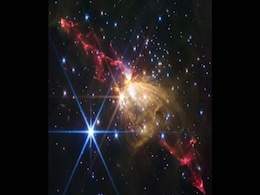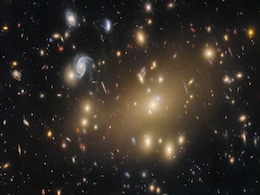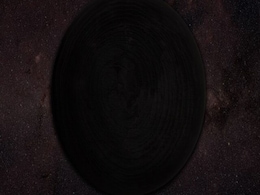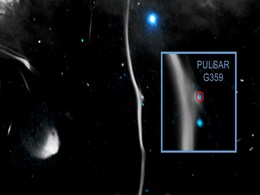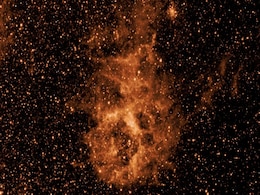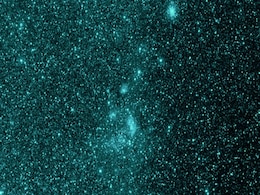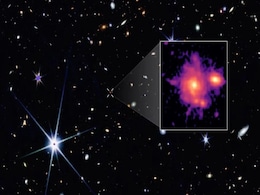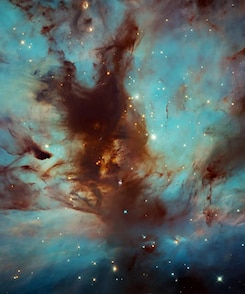Nasa Milky Way
- All
- News
- Web Stories
-

Flattened Dark Matter May Explain Mysterious Gamma-Ray Glow at Milky Way’s Core, Study Finds
- Sunday October 26, 2025
- Written by Gadgets 360 Staff
Dark matter near the Milky Way’s center appears flattened, not spherical, according to new simulations. The discovery may explain a puzzling gamma-ray glow long observed by NASA’s Fermi telescope, reigniting theories that dark matter collisions produce high-energy radiation in the galaxy’s core
-
 www.gadgets360.com
www.gadgets360.com
-

James Webb Space Telescope Spots Rare Protostar Blasting Twin Jets Across Milky Way
- Friday September 12, 2025
- Written by Gadgets 360 Staff
NASA’s James Webb Space Telescope has captured a rare protostar about ten times the Sun’s mass blasting twin jets nearly eight light-years long. The beams carve through the glowing Sharpless 2-284 nebula, offering astronomers a vivid glimpse into how massive stars form and shape their galactic environment.
-
 www.gadgets360.com
www.gadgets360.com
-

Hubble Uncovers Multi-Age Stars in Ancient Cluster, Reshaping Galaxy Origins
- Saturday July 19, 2025
- Written by Gadgets 360 Staff
A stunning new image from NASA’s Hubble Space Telescope reveals that ancient star cluster NGC 1786—located 160,000 light-years away in the Large Magellanic Cloud—hosts stars of varying ages. Once believed to contain a single generation of stars, NGC 1786 now appears to preserve a more complex stellar history. This multi-age discovery suggests...
-
 www.gadgets360.com
www.gadgets360.com
-

Scientists Say Dark Matter Could Turn Failed Stars Into ‘Dark Dwarfs’
- Friday July 11, 2025
- Written by Gadgets 360 Staff
Astronomers suggest that brown dwarfs—dim, failed stars—could transform into “dark dwarfs” by capturing dark matter in their cores. When dark matter particles annihilate, they release heat, potentially lighting up these stars. Physicist Jeremy Sakstein and researchers like Jillian Paulin and Rebecca Leane support this idea, which could help...
-
 www.gadgets360.com
www.gadgets360.com
-

NASA Reveals a Fracture in Huge Cosmic Bone: Everything You Need to Know
- Monday May 12, 2025
- Written by Gadgets 360 Staff
With the use of the Chandra X-Ray Observatory, NASA has detected a fracture in the Milky Way. The bone is a galactic center filament that is based at a distance of 26,000 light years from Earth. The fracture would have occurred due to collisions with the neutron star, known as a pulsar, that spins rapidly. The scientists suspect that the fracture w...
-
 www.gadgets360.com
www.gadgets360.com
-

NASA’s SPHEREx Telescope Begins 3D Infrared Mapping of the Universe
- Monday May 12, 2025
- Written by Gadgets 360 Staff
NASA’s SPHEREx space telescope has officially begun its two-year mission to map the entire sky in infrared light, capturing 3,600 images per day and covering 102 different wavelengths. The observatory aims to chart hundreds of millions of galaxies in 3D and uncover clues about the universe’s earliest moments. It will also trace the presence of ...
-
 www.gadgets360.com
www.gadgets360.com
-

NASA’s New Space Telescope Starts Mapping to Reveal Universe’s Deep Mysteries
- Monday May 5, 2025
- Written by Gadgets 360 Staff
NASA’s SPHEREx space telescope has begun its mission to scan the entire sky in 102 infrared wavelengths, capturing 3,600 images daily. Over the next two years, it will create a 3D map of hundreds of millions of galaxies, explore cosmic inflation, and search for life-forming ingredients in the Milky Way—unlocking new insights into the universe...
-
 www.gadgets360.com
www.gadgets360.com
-

NASA James Webb Space Telescope Discovers Farthest Spiral Galaxy, Reveals Clues About Galactic Evolution
- Saturday April 19, 2025
- Written by Gadgets 360 Staff
JWST discovers Zhúlóng, the earliest Milky Way-like galaxy, 800 million years after the Big Bang explosion occurred.
-
 www.gadgets360.com
www.gadgets360.com
-

NASA’s Hubble Space Telescope Tracks a Neutron Star With Mysterious Origin
- Wednesday April 16, 2025
- Written by Gadgets 360 Staff
NASA’s Hubble Space Telescope spotted a rogue magnetar, dubbed SGR 0501+4516, traversing our galaxy for a significantly long time. As per claims by scientists, it was first discovered in the year 2008 by NASA's Swift Observatory as intense flashes of gamma rays in the outer area of the Milky Way
-
 www.gadgets360.com
www.gadgets360.com
-

NASA’s SPHEREx Mission Sends First Space Images Before Full Sky Survey
- Thursday April 3, 2025
- Written by Gadgets 360 Staff
NASA’s SPHEREx telescope has captured its first images from space, marking a critical milestone before its full-sky infrared survey begins. The observatory, launched on March 11, recorded thousands of light sources, including distant galaxies and stars. Unlike other space telescopes, SPHEREx is designed for large-scale cosmic mapping, scanning th...
-
 www.gadgets360.com
www.gadgets360.com
-

Video: NASA Launches SPHEREx Telescope To Explore Universe's Origins
- Wednesday March 12, 2025
- World News | Reuters
A NASA telescope was launched into space from California on Tuesday for a mission to explore the origins of the universe and to scour the Milky Way galaxy for hidden reservoirs of water, a key ingredient for life.
-
 www.ndtv.com
www.ndtv.com
-

New Dark Matter Hypothesis Suggests Ionisation Clue in Milky Way’s Core
- Wednesday March 12, 2025
- Written by Gadgets 360 Staff
Researchers propose that an overlooked dark matter candidate may explain unusual ionisation levels in the Milky Way’s Central Molecular Zone (CMZ). This theory suggests that lightweight, self-annihilating dark matter particles could be producing electrons and positrons, influencing cosmic chemistry. The findings challenge conventional views, offe...
-
 www.gadgets360.com
www.gadgets360.com
-

NASA’s SPHEREx Telescope Launching Aboard SpaceX Falcon 9 to Explore Cosmic Evolution
- Friday February 28, 2025
- Written by Gadgets 360 Staff
NASA’s SPHEREx telescope, launching on Feb 28 aboard a SpaceX Falcon 9, will map the entire sky in infrared, observing 450 million galaxies and 100 million Milky Way stars. The mission aims to uncover the large-scale structure of the universe, track icy molecules in interstellar space, and study cosmic inflation. Equipped with a spectrophotometer...
-
 www.gadgets360.com
www.gadgets360.com
-

James Webb Space Telescope Captures Sagittarius A Emitting Continuous Flares in Milky Way’s Core
- Thursday February 20, 2025
- Written by Gadgets 360 Staff
The James Webb Space Telescope has captured Sagittarius A*, the Milky Way’s supermassive black hole, emitting flares continuously. These bursts, varying in intensity and duration, have been observed over multiple sessions. Scientists believe the activity may be linked to magnetic interactions within the accretion disk. The phenomenon appears rand...
-
 www.gadgets360.com
www.gadgets360.com
-

NASA SPHEREx Mission to Map Water Ice in the Milky Way for Life’s Origins
- Monday February 17, 2025
- Written by Gadgets 360 Staff
NASA’s SPHEREx mission, launching February 27, will search for water ice and frozen compounds in the Milky Way’s molecular clouds. By surveying over 9 million regions, the mission aims to understand how these compounds influence planet and star formation. Findings will complement data from the James Webb Space Telescope, enhancing insights into...
-
 www.gadgets360.com
www.gadgets360.com
-

Flattened Dark Matter May Explain Mysterious Gamma-Ray Glow at Milky Way’s Core, Study Finds
- Sunday October 26, 2025
- Written by Gadgets 360 Staff
Dark matter near the Milky Way’s center appears flattened, not spherical, according to new simulations. The discovery may explain a puzzling gamma-ray glow long observed by NASA’s Fermi telescope, reigniting theories that dark matter collisions produce high-energy radiation in the galaxy’s core
-
 www.gadgets360.com
www.gadgets360.com
-

James Webb Space Telescope Spots Rare Protostar Blasting Twin Jets Across Milky Way
- Friday September 12, 2025
- Written by Gadgets 360 Staff
NASA’s James Webb Space Telescope has captured a rare protostar about ten times the Sun’s mass blasting twin jets nearly eight light-years long. The beams carve through the glowing Sharpless 2-284 nebula, offering astronomers a vivid glimpse into how massive stars form and shape their galactic environment.
-
 www.gadgets360.com
www.gadgets360.com
-

Hubble Uncovers Multi-Age Stars in Ancient Cluster, Reshaping Galaxy Origins
- Saturday July 19, 2025
- Written by Gadgets 360 Staff
A stunning new image from NASA’s Hubble Space Telescope reveals that ancient star cluster NGC 1786—located 160,000 light-years away in the Large Magellanic Cloud—hosts stars of varying ages. Once believed to contain a single generation of stars, NGC 1786 now appears to preserve a more complex stellar history. This multi-age discovery suggests...
-
 www.gadgets360.com
www.gadgets360.com
-

Scientists Say Dark Matter Could Turn Failed Stars Into ‘Dark Dwarfs’
- Friday July 11, 2025
- Written by Gadgets 360 Staff
Astronomers suggest that brown dwarfs—dim, failed stars—could transform into “dark dwarfs” by capturing dark matter in their cores. When dark matter particles annihilate, they release heat, potentially lighting up these stars. Physicist Jeremy Sakstein and researchers like Jillian Paulin and Rebecca Leane support this idea, which could help...
-
 www.gadgets360.com
www.gadgets360.com
-

NASA Reveals a Fracture in Huge Cosmic Bone: Everything You Need to Know
- Monday May 12, 2025
- Written by Gadgets 360 Staff
With the use of the Chandra X-Ray Observatory, NASA has detected a fracture in the Milky Way. The bone is a galactic center filament that is based at a distance of 26,000 light years from Earth. The fracture would have occurred due to collisions with the neutron star, known as a pulsar, that spins rapidly. The scientists suspect that the fracture w...
-
 www.gadgets360.com
www.gadgets360.com
-

NASA’s SPHEREx Telescope Begins 3D Infrared Mapping of the Universe
- Monday May 12, 2025
- Written by Gadgets 360 Staff
NASA’s SPHEREx space telescope has officially begun its two-year mission to map the entire sky in infrared light, capturing 3,600 images per day and covering 102 different wavelengths. The observatory aims to chart hundreds of millions of galaxies in 3D and uncover clues about the universe’s earliest moments. It will also trace the presence of ...
-
 www.gadgets360.com
www.gadgets360.com
-

NASA’s New Space Telescope Starts Mapping to Reveal Universe’s Deep Mysteries
- Monday May 5, 2025
- Written by Gadgets 360 Staff
NASA’s SPHEREx space telescope has begun its mission to scan the entire sky in 102 infrared wavelengths, capturing 3,600 images daily. Over the next two years, it will create a 3D map of hundreds of millions of galaxies, explore cosmic inflation, and search for life-forming ingredients in the Milky Way—unlocking new insights into the universe...
-
 www.gadgets360.com
www.gadgets360.com
-

NASA James Webb Space Telescope Discovers Farthest Spiral Galaxy, Reveals Clues About Galactic Evolution
- Saturday April 19, 2025
- Written by Gadgets 360 Staff
JWST discovers Zhúlóng, the earliest Milky Way-like galaxy, 800 million years after the Big Bang explosion occurred.
-
 www.gadgets360.com
www.gadgets360.com
-

NASA’s Hubble Space Telescope Tracks a Neutron Star With Mysterious Origin
- Wednesday April 16, 2025
- Written by Gadgets 360 Staff
NASA’s Hubble Space Telescope spotted a rogue magnetar, dubbed SGR 0501+4516, traversing our galaxy for a significantly long time. As per claims by scientists, it was first discovered in the year 2008 by NASA's Swift Observatory as intense flashes of gamma rays in the outer area of the Milky Way
-
 www.gadgets360.com
www.gadgets360.com
-

NASA’s SPHEREx Mission Sends First Space Images Before Full Sky Survey
- Thursday April 3, 2025
- Written by Gadgets 360 Staff
NASA’s SPHEREx telescope has captured its first images from space, marking a critical milestone before its full-sky infrared survey begins. The observatory, launched on March 11, recorded thousands of light sources, including distant galaxies and stars. Unlike other space telescopes, SPHEREx is designed for large-scale cosmic mapping, scanning th...
-
 www.gadgets360.com
www.gadgets360.com
-

Video: NASA Launches SPHEREx Telescope To Explore Universe's Origins
- Wednesday March 12, 2025
- World News | Reuters
A NASA telescope was launched into space from California on Tuesday for a mission to explore the origins of the universe and to scour the Milky Way galaxy for hidden reservoirs of water, a key ingredient for life.
-
 www.ndtv.com
www.ndtv.com
-

New Dark Matter Hypothesis Suggests Ionisation Clue in Milky Way’s Core
- Wednesday March 12, 2025
- Written by Gadgets 360 Staff
Researchers propose that an overlooked dark matter candidate may explain unusual ionisation levels in the Milky Way’s Central Molecular Zone (CMZ). This theory suggests that lightweight, self-annihilating dark matter particles could be producing electrons and positrons, influencing cosmic chemistry. The findings challenge conventional views, offe...
-
 www.gadgets360.com
www.gadgets360.com
-

NASA’s SPHEREx Telescope Launching Aboard SpaceX Falcon 9 to Explore Cosmic Evolution
- Friday February 28, 2025
- Written by Gadgets 360 Staff
NASA’s SPHEREx telescope, launching on Feb 28 aboard a SpaceX Falcon 9, will map the entire sky in infrared, observing 450 million galaxies and 100 million Milky Way stars. The mission aims to uncover the large-scale structure of the universe, track icy molecules in interstellar space, and study cosmic inflation. Equipped with a spectrophotometer...
-
 www.gadgets360.com
www.gadgets360.com
-

James Webb Space Telescope Captures Sagittarius A Emitting Continuous Flares in Milky Way’s Core
- Thursday February 20, 2025
- Written by Gadgets 360 Staff
The James Webb Space Telescope has captured Sagittarius A*, the Milky Way’s supermassive black hole, emitting flares continuously. These bursts, varying in intensity and duration, have been observed over multiple sessions. Scientists believe the activity may be linked to magnetic interactions within the accretion disk. The phenomenon appears rand...
-
 www.gadgets360.com
www.gadgets360.com
-

NASA SPHEREx Mission to Map Water Ice in the Milky Way for Life’s Origins
- Monday February 17, 2025
- Written by Gadgets 360 Staff
NASA’s SPHEREx mission, launching February 27, will search for water ice and frozen compounds in the Milky Way’s molecular clouds. By surveying over 9 million regions, the mission aims to understand how these compounds influence planet and star formation. Findings will complement data from the James Webb Space Telescope, enhancing insights into...
-
 www.gadgets360.com
www.gadgets360.com


